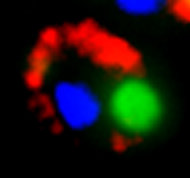Blockade in Cellular Waste Disposal - Max Planck Scientists Show How Protein Aggregates Disrupt the Molecular Balance of the Cell
Proteins can only perform their complex functions in the cell when they assume a specific three-dimensional structure for each respective task. Because misfolded proteins are often toxic, they are immediately refolded or degraded. Scientists of the Max Planck Institute (MPI) of Biochemistry in Martinsried near Munich have now shown in the yeast model that specific protein aggregates block an important degradation pathway for defective proteins – and thus disrupt the fragile molecular balance of the cell. The results of the study have now been published in the journal Cell.

Protein aggregates in cells can cause severe diseases such as Huntington’s disease. The massive movement disorders that appear with this disease are likely caused by aggregates of specific proteins, the polyQ proteins. Scientists of the research department “Cellular Biochemistry” headed by F.-Ulrich Hartl have now shown how these protein aggregates, commonly known as plaques, seriously disrupt cellular homeostasis.
Cells in the balance
The entire set of all cellular proteins is referred to as the proteome, whose composition is determined by a delicate balance of protein production and degradation. This process is regulated at several levels. Key helpers here are the molecular chaperones which aid the proteins in proper folding or lead them to degradation if the misfolding is irreparable. Among other things, this procedure serves to prevent the formation of protein plaques. Hartl’s team has now succeeded in demonstrating that polyQ aggregates in yeast primarily have an effect on the chaperone Sis1p.
This molecule functions as a cellular shuttle: It transports misfolded proteins from the cytosol into the cell nucleus, where they are degraded. The harmful polyQ plaques block this process by intercepting Sis1p. “As a result, misfolded proteins accumulate in the cell, which may contribute to the toxicity of polyQ aggregates,” said Sae-Hun Park, scientist at the MPI of Biochemistry and first author of the study.
Similar processes may occur in polyQ diseases in humans. Also in mammalian cells, misfolded proteins are transported from the cytosol into the nucleus. Here the chaperone DnajB1 plays a role similar to Sis1p in the yeast model. Contrary to prevailing opinion, Hartl’s team even assumes that this degradation pathway is the most important means of clearance of misfolded proteins from the cell interior. Further studies shall now show whether and to what extent these fundamental processes play a role in the pathogenic protein plaques.
Original publication:
Sae-Hun Park, Yury Kukushkin, Rajat Gupta, Taotao Chen, AyanoKonagai, Mark S. Hipp, Manajit Hayer-Hartl, F.Ulrich Hartl: PolyQ Proteins Interfere with Nuclear Degradation of Cytosolic Proteins by Sequestering the Sis1p Chaperone, Cell, June 20, 2013.
DOI: 10.1016/j.cell.2013.06.003












